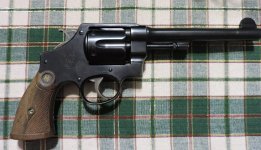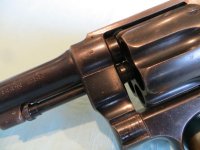smithywess
Member
- Joined
- Jan 4, 2008
- Messages
- 24
- Reaction score
- 18
I am quite happy that I have acquired a new revolver which is in very fine shape and in it's original calibre of .455 Webley. I'm sure there are experts here who would find this quite common but I have been loading this calibre for a Mark VI Webley for 20 years now and always wanted the Smith & Wesson Government contract revolver made for the British in the Great War of 1914. This one I have hardly seems used. There is a faint cylinder line. It's serial # is 52XXX. This # appears under the barrel with the letter"B" ahead of it by half an inch, on the face of the cylinder, on the bottom of the grip and in pencil under the right grip. There is another #6319 on the frame just above the crane hinge. There is the Remington UMC crossed pennant acceptance mark on the left just below the barrel pin and another on the face of the cylinder. On the left at the rear of the frame behind the hammer is a broad arrow below which is stamped a crown and below that " E 6" and below that "E" and beneath this a II signifying the Second Model hand ejector. There are no other British markings. There is a lanyard 'ring' although it's rectangular. The revolver has the same finish in blue as a Model 29 and a Model 17 that I own. Unbelievably it slugs to .452" and even better the cylinder throats are .453" and a cast bullet ( 265-RCBS-HB) sized .452" falls through the chambers. Each one is exactly the same diameter. I think this revolver will be a very fine shooter, and I might be inclined to shoot unsized bullets as they drop from my mould at .453"in 1:20 Sn b alloy. The trigger pull on this revolver is as good as my other two Smiths and a thousand times better that the Webley Mark VI. I plan to conduct an experiment as to which case, Mark I or Mark II, is the more accurate one. I am using Hornady Mark II brass and am forming some Mark I cases from .45 Colt brass on a lathe. Are other Forum members interested in this type of thing ? I'm not a frequent poster. Thanks.
b alloy. The trigger pull on this revolver is as good as my other two Smiths and a thousand times better that the Webley Mark VI. I plan to conduct an experiment as to which case, Mark I or Mark II, is the more accurate one. I am using Hornady Mark II brass and am forming some Mark I cases from .45 Colt brass on a lathe. Are other Forum members interested in this type of thing ? I'm not a frequent poster. Thanks.
Attachments
Last edited:






